Lesson Objective
- Have an understanding and knowledge of the basic internal components of the CPU.
- Describe the purpose of a bus and how the address, control and data bus are used.
- Understand the concept of addressable memory.
KS3, GCSE, A-Level Computing Resources
This diagram shows the basic internal components of a computer system.
Key components are identified in the CPU and Computer System.
The system bus is not inside the CPU. It's on the motherboard and connects the CPU to other important parts of the computer system, such as the main memory (RAM) and sometimes other caches. In contrast, there are internal buses within the CPU that allow communication between its various parts. Think of the system bus as a highway connecting different cities, and the internal CPU buses as streets within a city.

The Processor
It is the brain of the computer. The processor is a device that carries out computation. The processor executes instructions and processes information.
What is it made of?
Main Memory
RAM (Random Access memory)
ROM (Read only memory)
Keyboard Input Controller
A keyboard input controller in the CPU is a hardware device that is integrated into the CPU itself. It is responsible for handling all keyboard input, from the moment a key is pressed until the corresponding character is displayed on the screen. Some specific tasks that a keyboard input controller in the CPU performs:
Disk I/O Controller
A disk I/O controller in a processor is a hardware component that manages the transfer of data between the processor and disk storage devices. It is responsible for translating commands from the processor into signals that the disk drive can understand, and vice versa. Some of the specific tasks that a disk I/O controller performs include:
Video Display Unit (VDU) Controller
A VDU controller is a specialized integrated circuit that is responsible for controlling the display of text and graphics on a monitor. It is typically integrated into the processor or motherboard of a computer.
The VDU controller performs a number of tasks, including:
Buses
Buses in a computer consist of a series of wires that transfer data signals between internal components. They typically consist of 8, 16, 32 or 64 lines.


The Three Box Model
Hardware refers to the physical components of a computer system. The core components of any computer system are:
The processor controls the system bus and the system bus communicates between the all three boxes.
In order to perform operations on data the processor must get the data from main memory first.
An addressable memory system is used where each storage location in main memory has a unique address called a main memory address.
The Three Buses (System Bus)
Image of Bus and Component Connections:

Memory is divided up in equal units called words (smallest addressable unit - total amount of bits).
The width of the data bus is defined by the number of wires or lines it contains.
If the data bus is the same width as a computer word, data can be transferred to and from memory in a single operation.
If it is 16 lines and a word is 32 bits, it will require two memory access and data transfer operations.
Bus width affects overall system performance.